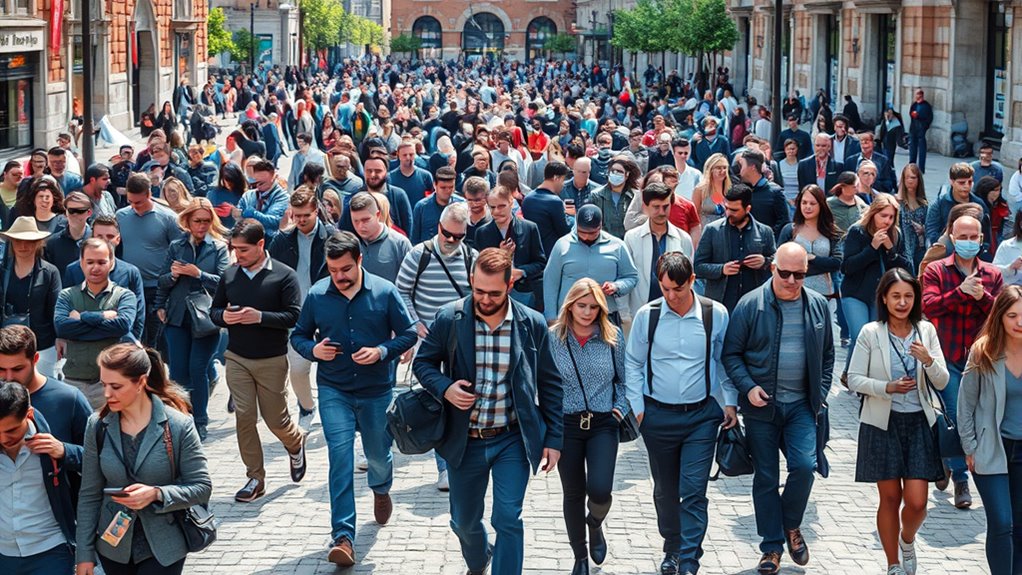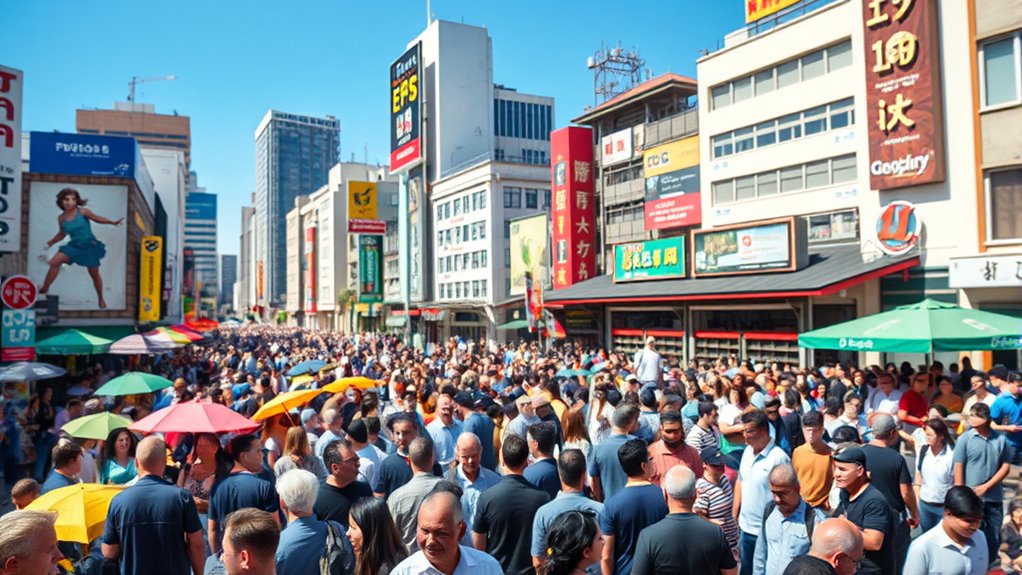AI tools for creating realistic crowd scenes help you generate lifelike human behaviors, interactions, and responses with ease. They reduce the need for large groups of extras and complex choreography by producing seamless virtual crowds that adapt to your scene’s environment. You can customize appearances, emotional reactions, and movement patterns for each virtual extra, ensuring natural and dynamic interactions. If you keep exploring, you’ll discover how these tools can transform your scene production process further.
Key Takeaways
- AI-powered crowd simulation reduces the need for large extras and choreographed movements, saving time and costs.
- Customizable virtual extras can be tailored in appearance, behavior, and emotional responses for increased scene realism.
- Real-time scene preview and feedback enable quick adjustments for natural-looking crowd interactions from multiple angles.
- AI analyzes scene environments to generate dynamic, context-aware crowd behaviors that respond to lighting, camera angles, and scene elements.
- These tools facilitate the creation of immersive, large-scale scenes like city streets, stadiums, or protests with greater efficiency and authenticity.

Creating realistic crowd scenes can be a complex and time-consuming task, but AI tools are transforming this process by making it faster and more accurate. With advancements in crowd simulation technology, you can now generate large, dynamic crowds without the need for dozens of extras on set. AI-powered crowd simulation software analyzes environments and creates virtual extras that behave naturally, mimicking real human movement and interactions. This allows you to fill scenes with hundreds or even thousands of virtual extras that respond to camera angles, lighting, and other scene elements seamlessly.
Using AI for crowd simulation means you don’t have to rely on traditional methods like hiring large groups of extras or painstakingly choreographing each movement. Instead, the AI algorithms generate realistic behaviors based on context—people walking, talking, reacting, and interacting as they would in real life. This not only saves time and money but also provides you with greater control over the scene’s composition. You can adjust crowd density, movement patterns, and even individual behaviors to match your creative vision precisely.
AI-driven crowd simulation reduces the need for extras and choreographed movements, offering realistic behaviors and greater scene control.
Moreover, AI tools allow for easy customization of virtual extras. You can modify their appearance, clothing, and even their emotional responses to suit the scene’s mood. Because the AI continuously learns from real-world data, the virtual extras become increasingly lifelike and believable. This is especially useful for scenes set in large public spaces where crowd behavior is complex and unpredictable. With AI-driven crowd simulation, you gain the ability to create bustling city streets, packed stadiums, or chaotic evacuation scenes with minimal effort.
Another advantage is the ability to preview scenes in real-time. You can see how your virtual extras move and interact within the scene, making adjustments on the fly. This immediate feedback loop improves accuracy and ensures the crowd looks natural from every angle. When post-production comes around, the AI-enhanced crowd scenes are easier to integrate with live footage or CGI backgrounds, reducing the need for extensive editing.
In essence, AI tools for crowd simulation empower you to craft immersive, realistic scenes without the logistical headaches of traditional methods. They provide a cost-effective and efficient way to generate virtual extras that elevate your production quality. Whether you’re creating a busy marketplace, a chaotic protest, or a stadium filled with fans, these AI-driven solutions help bring your vision to life with precision and authenticity. Leveraging AI content clusters can further optimize your scene planning and execution by organizing related visual elements and behaviors systematically.
Frequently Asked Questions
Can AI Tools Generate Crowd Scenes in Real-Time?
Yes, AI tools can generate crowd scenes in real-time, leveraging dynamic rendering and real-time simulation. You can see instant updates as the crowd moves and reacts, making scenes look highly realistic and immersive. These tools analyze data quickly, allowing you to manipulate crowd behavior, density, and patterns on the fly. This capability is especially useful for live events, gaming, and virtual production, where real-time responsiveness enhances the overall experience.
What Are the Best AI Tools for Low-Budget Projects?
For low-budget projects, you should explore budget-friendly options and open source solutions like Blender, which offers powerful crowd simulation features for free. You can also try Godot, an open source game engine with crowd scripting capabilities. These tools give you the flexibility to create realistic crowd scenes without breaking the bank, making them perfect for your budget-conscious projects.
How Do AI Tools Handle Diverse Crowd Demographics?
A picture is worth a thousand words, especially in crowd scenes. AI tools handle diverse demographics by using extensive datasets that include various cultural representations. They generate realistic crowd scenes with accurate demographic diversity, ensuring different ages, ethnicities, and styles are represented. These tools adapt to your project’s needs, making your scenes authentic and inclusive without extra effort, effectively capturing the richness of real-world populations.
Are Ai-Generated Crowd Scenes Suitable for Professional Films?
AI-generated crowd scenes can be suitable for professional films if you focus on crowd authenticity and address realism challenges. These tools can efficiently produce large, varied crowds, saving time and resources. However, you need to carefully evaluate the scene’s realism, ensuring the crowd looks natural and diverse. When used thoughtfully, AI can enhance your film’s visuals, but always review for any unnatural patterns that might break immersion.
What Are the Ethical Considerations When Creating Virtual Crowds?
When creating virtual crowds, you should consider privacy concerns and representation ethics. You might inadvertently depict individuals in ways that violate privacy or reinforce stereotypes. It’s essential to guarantee that virtual crowds are diverse and respectful, avoiding misrepresentation or harmful stereotypes. Always evaluate how your digital scenes impact viewers and avoid using real people’s data without consent. By doing so, you uphold ethical standards and foster responsible content creation.
Conclusion
So, now you’ve got all these AI tools at your fingertips to craft stunning, lifelike crowd scenes. Ironically, while they make creating crowds easier than ever, you might find yourself more overwhelmed by the endless possibilities than actual crowds themselves. But hey, who needs real people when you can generate entire bustling scenes with just a few clicks? Embrace the virtual chaos—you might just prefer it over the real thing.









